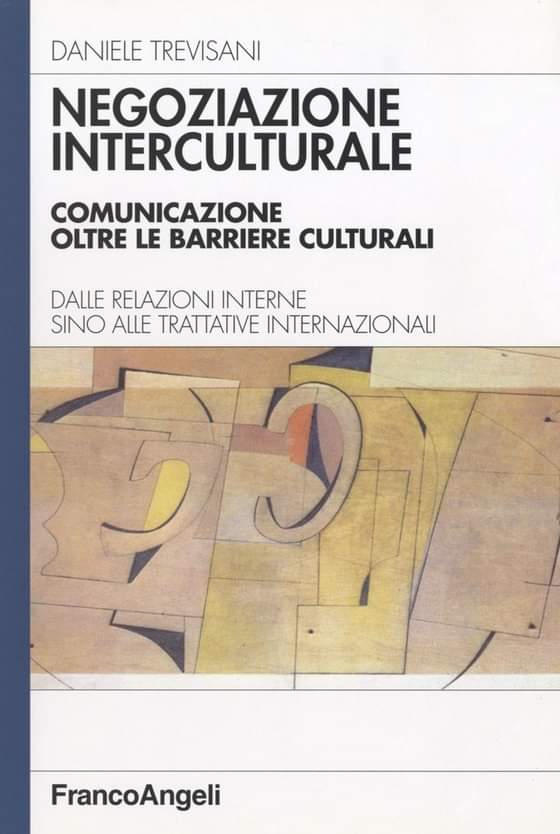© Article translated from the book “Negoziazione interculturale, comunicazione oltre le barriere culturali” (Intercultural Negotiation: Communication Beyond Cultural Barriers) copyright Dr. Daniele Trevisani Intercultural Negotiation Training and Coaching, published with the author’s permission. The Book’s rights are on sale and are available for any Publisher wishing to consider it for publication in English and other languages except for Italian and Arab whose rights are already sold and published. If you are interested in publishing the book in English, or any other language, or seek Intercultural Negotiation Training, Coaching, Mentoring and Consulting, please feel free to contact the author from the webstite www.danieletrevisani.com
__________
In this article I will examine 2 important topics of intercultural negotiation communication: the first concerns the personal image management, while the second one is related to the superiority-inferiority conflict.
In every negotiation comparing respective statuses becomes inevitable. However, statuses are considered intra-cultural and not cross-cultural elements. We cannot assume that a person belonging to an “other” culture recognizes a status that comes from an unknown system.
Let’s observe this real dialogue between two colleagues at a restaurant, the first is Italian and the second one is American.
US negotiator: “In America my family is in the upper-middle class, we have a thousand square meter apartment in New York, but my neighbours built a mezzanine, doubling the airspace, if business goes well next season I can enter the upper class, and build a mezzanine too. My children have two PlayStations each, and I’m giving them a good education: for each hour of study I multiply x 2 their possibility of using the PlayStation, so if they study an hour I let them use the PlayStation for 2 hours, if they study 15 minutes I let them use it for only half an hour, timed.”
Italian’s response: “But do you listen to your children or do you time them?” (unspoken thought: you can also have a mezzanine of a square kilometre, but for me you are always an asshole)
We are not interested here in discussing who is wrong and if someone is wrong, but it is clear that the American interlocutor is exposing a particular image of himself. He is expressing a “face” and he is indirectly exposing which are the status rules he believes in, and his convictions on the most appropriate pedagogical methods. For this person having a mezzanine and two PlayStations is an indicator of status. It is also clear that the Italian interlocutor does not accept these rules and that he measures personal value differently.
A more or less conscious management of one’s “social face” is part of every negotiation. However, on an intercultural level, sending out unconscious messages and producing damages during negotiations can be very easy.
Principle 20 – Managing one’s own status and the interlocutor’s status; “face” games and intercultural impressions management
The success of intercultural negotiation depends on:
- the ability to create an adequate status perception within the interlocutor’s judgment system;
- the ability to create positive impressions (identity management and impression management);
- the ability to acquire status and “face” without resorting to undue attack mechanisms, that can damage others’ “faces” (“face” aggression or personal image reduction, absolute avoidance of top-down approaches);
Alain de Botton reports this passage which shows us how even at the highest diplomatic and negotiating levels one can be very ignorant of what transversal messages are being emitted and of the degree of damage that can be produced by knowingly or not knowingly placing oneself in a top-down position.
In July 1959, US Vice President Richard Nixon went to Moscow to inaugurate an exhibition dedicated to his country’s technological and material innovations. The main attraction was a life-size copy of the house of the average worker, with carpet, TV in the living room, two bathrooms, central heating and a kitchen equipped with a washing machine, a dryer and a refrigerator.
During various press services, the Soviet press, somewhat irritated, declared that no American worker could have lived in such a luxurious house – ironically named “Taj Mahal” by Soviets – and defined it a means of propaganda.
Khrushchev maintained a rather sceptical attitude when he accompanied Nixon to the exhibition. As he observed the kitchen of the house in question, the Soviet leader pointed to an electric juicer and said that no sane person would ever think of buying certain “stupid items”. “Anything that can help a woman doing her work is useful,” Nixon replied. “We do not consider women as workers, as you do in the capitalist system,” Khrushchev retorted angrily.
Later that evening, Nixon was invited to give a speech at the Soviet television and used the occasion to illustrate the benefits of the American way of life. Cunningly, he did not begin to speak of democracy and human rights, but of money and material progress. He explained that, thanks to entrepreneurship and industrial activity, in a few centuries Western countries had managed to overcome poverty and famine, which were widespread until the mid-eighteenth century and still present in many areas of the world. Americans owned fifty-six million televisions and one hundred and fifty-three million radios according to what Nixon reported to Soviet viewers, many of whom did not even have a private bathroom or a kettle for making tea. About thirty-one million Americans lived in their own home, and an average family was able to buy nine clothes and fourteen pairs of shoes a year. In the United States, you could buy a house by choosing from a thousand different architectural styles, and o certain houses were often larger than a television studio. At that point Khrushchev, sitting next to Nixon and increasingly irritated, clenched his fists and exclaimed “Net, Net! “, while apparently adding in an undertone ” Eb ’tvoju babusku” (Go fuck your grandmother).
What clearly emerges from this passage is the (perhaps) unwitting offense to poverty that Nixon transfers to Russian people, placing himself in a top-down position, superior position vs. lower position.
For too many times, negotiators do not realize that they are performing an “abuse of dominant position” (displaying excessive superiority that damages others) or practicing a “presumption of dominance” (thinking of oneself in superior terms).
Communication reveals self- conceptions and relationship conceptions even though the participants do not want to reveal them.
Let’s see another example and observe some passages of this email:
Dr Trevisani
Two colleagues and I are close to retirement and after an intense activity as top managers in various multinationals we decided to create an external company. I ask you to be our consultant and to provide us with your valuable advices to help us build a successful company. Do your best to check if you can come to advise us in Turin. Anyway, send me a commercial offer because I must show it to my partners for approval. Please send me also your CV. I will present it to my two partners, so as to persuade them to approve your advice. This consultancy intervention must be done within January 2005.
Thank you in advance for your help.
signature
This message intercultural problem is of psycholinguistic type and it concerns the use of the imperative and the enormous quantity of presuppositions present.
Let’s look at some implicit assumptions linked to this message:
- some people believe that a commercial offer can be made without having analysed the problem and the necessary intervention times;
- Others think that the recipient will send his CV to someone he/she does not know, without being informed on how and for what purposes this CV will be used (it takes only a few seconds to write a writing a reason on an email, but the real motives can be different);
- There is also the assumption that the customer can dictate times and that it is the recipient, and not the writer, who must make the trip;
- It is taken for granted that the recipient wants to work for the sender and that he approves intentions and projects.
The apparently courteous message reveals a culture that is not exactly courteous.
In the Italian culture being in the “buyer” position is a strength and working for years in a multinational company makes the buyer acquire a strongest attitude of strength and superiority.
The sender actually expresses an aggressive multinational culture, which is based on the belief that a multinational can “rule the world”, a way of being consequently absorbed by its managerial education. However, the Italian culture is not unique, and we cannot think that the prototype of the multinational’s dominance over a consultant, or of a buyer over a possible seller, is accepted by everyone.
The ALM method culture believes that there must be a certain degree of values commonality for a project to start.
We must always consider that our culture is not automatically the culture of others. The right strategy is therefore to avoid putting the counterpart in conditions of presumed inferiority or to assign automatic superiority.

© Article translated from the book “Negoziazione interculturale, comunicazione oltre le barriere culturali” (Intercultural Negotiation: Communication Beyond Cultural Barriers) copyright Dr. Daniele Trevisani Intercultural Negotiation Training and Coaching, published with the author’s permission. The Book’s rights are on sale and are available for any Publisher wishing to consider it for publication in English and other languages except for Italian and Arab whose rights are already sold and published. If you are interested in publishing the book in English, or any other language, or seek Intercultural Negotiation Training, Coaching, Mentoring and Consulting, please feel free to contact the author from the webstite www.danieletrevisani.com
__________
For further information see:
- Studio Trevisani Academy’s Webstite For Business Training, Coaching and Mentoring, in Italian
- Dr. Daniele Trevisani’s Website in Italian
- Dr. Daniele Trevisani’s Website in English
- Comunicazioneaziendale.it – Italian website on Business Communication
- Medialab Research Cultural Association for Communication Research
- Dr. Daniele Trevisani Linkedin Profile in English
- Facebook Channel
- YouTube Channel
TAGS:
- ALM business method
- active training
- awareness of one’s role in negotiation
- Best coach in intercultural communication in the world
- Best coach in intercultural facilitation in the world
- Best coach in intercultural negotiation in the world
- Best Intercultural communication book
- Best world consultant in intercultural communication
- Best world consultant in intercultural negotiation
- Best world expert in intercultural communication
- Best world expert in intercultural negotiation
- Best world trainer in intercultural communication
- Best world trainer in intercultural negotiation
- Best Intercultural negotiation book
- book on intercultural communication
- book on intercultural negotiation communication
- communication difficulties
- communication skills
- Communication techniques intercultural communication
- Communication techniques intercultural negotiation
- communication training
- conversational skills
- creative strategies
- cross cultural communication
- cross cultural misunderstanding
- cross-cultural adaptation
- cultural systems
- dialogue between companies
- different cultural approach
- different cultural context
- direct line of communication
- disagreements
- Effective intercultural negotiation techniques
- face-to-face communication
- front-line communication
- high-context cultures
- How cultural differences affect negotiations?
- How does culture influence negotiation?
- intercultural communication
- intercultural communication book
- Intercultural communication books
- Intercultural Communication Coaching
- intercultural communication pdf
- Intercultural Communication Trainers
- Intercultural Communication Training
- Intercultural conversation management techniques
- Intercultural Negotiation
- Intercultural negotiation books
- Intercultural Negotiation Coach
- Intercultural Negotiation Coaching
- Intercultural Negotiation Communication
- Intercultural Negotiation Consultant
- Intercultural Negotiation Consulting
- Intercultural Negotiation Counselling
- intercultural negotiation definition
- Intercultural negotiation exercises
- Intercultural Negotiation in International Business
- Intercultural Negotiation Mentoring
- intercultural negotiation PDF
- Intercultural Negotiation Process
- Intercultural Negotiation Strategies
- Intercultural Negotiation Timing
- intercultural negotiation training
- intercultural training
- Intercultural Training Consultants
- know-how
- low-context cultures
- misunderstandings
- negotiating rules
- negotiator’s growth
- open communication
- transparent communication
- What are the 5 stages of negotiation?
- What is effective intercultural negotiation?
- What is intercultural negotiation?
- working on attitudes
- working on skills
- World’s most famous expert in intercultural communication
- World’s most famous expert in intercultural negotiation
- personal image management
- superiority-inferiority conflict
- Status
- personal beliefs
- personal convictions
- status rules
- social face
- unconscious messages
- transversal messages
- face” aggression
- personal image reduction
- avoidance of top-down approaches
- abuse of dominant position
- presumption of dominance
- implicit assumptions
- presuppositions
- aggressive multinational culture
- values commonality







